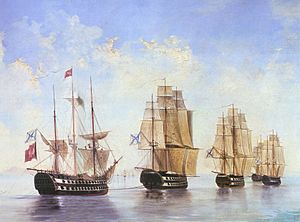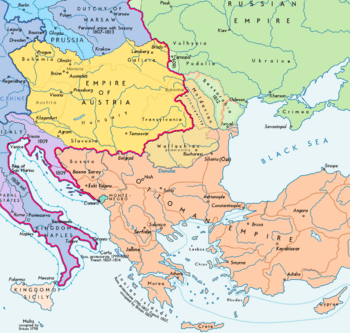Russo-Turkish War (1806–1812) facts for kids
Quick facts for kids Russo-Turkish War (1806–1812) |
|||||||||
|---|---|---|---|---|---|---|---|---|---|
| Part of the Russo-Turkish Wars and Napoleonic Wars | |||||||||
 Russian Fleet after the Battle of Athos by Alexey Bogolyubov |
|||||||||
|
|||||||||
| Belligerents | |||||||||
|
|
|||||||||
| Commanders and leaders | |||||||||
|
|
|||||||||
The Russo-Turkish War (1806–1812) was a big fight between the Russian Empire and the Ottoman Empire. Russia won this war. Both sides wanted peace because they were worried about Napoleon and his wars spreading eastward.
Contents
Why the War Started
This war happened during the time of the Napoleonic Wars. In 1806, the Ottoman ruler, Sultan Selim III, was encouraged by France. France had just seen Russia lose a battle. So, the Sultan removed two leaders, Constantine Ypsilantis and Alexander Mourousis. These leaders were friendly with Russia and ruled areas called Wallachia and Moldavia. These areas were like smaller countries under Ottoman control.
At the same time, France took over a place called Dalmatia. This made it seem like France might attack the areas near the Danube River. To protect its border from a possible French attack, Russia sent about 40,000 soldiers into Moldavia and Wallachia. The Sultan reacted by stopping Russian ships from using the Dardanelles strait. Then, he declared war on Russia.
First Battles
At first, the Russian Emperor Alexander I didn't want to send too many soldiers to fight the Ottomans. He wasn't sure what Napoleon would do, and most of his army was busy fighting Napoleon in Prussia.
- A large Ottoman attack on Bucharest, the capital of Wallachia, was stopped. Only 4,500 Russian soldiers, led by Mikhail Miloradovich, defeated them in June 1807.
- In Armenia, about 7,000 Russian soldiers, led by Count Gudovich, destroyed a Turkish force of 20,000 at Arpachai in June.
- Meanwhile, the Russian Imperial Navy under Dmitry Senyavin blocked the Dardanelles. They beat the Ottoman fleet in the Battle of the Dardanelles. After this, Sultan Selim III was removed from power.
- The Ottoman fleet was completely destroyed the next month in the Battle of Athos. This made Russia the strongest power at sea in that region.
Campaigns from 1808 to 1810
The war could have ended here, but then the Peace of Tilsit happened. This peace treaty forced Russia to sign a ceasefire with the Ottomans. Russia used this time to move more soldiers from Prussia to Bessarabia.
- The Russian army in the south grew to 80,000 soldiers. When fighting started again, the old commander, Prozorovsky, didn't make much progress.
- In August 1809, Prince Bagration took over. He quickly crossed the Danube River and took over Dobruja. Bagration then tried to capture Silistra. But when he heard a 50,000-strong Turkish army was coming, he decided to leave Dobruja and go back to Bessarabia.
In 1810, the fighting continued with brothers Nikolay and Sergei Kamensky leading the Russians.
- They defeated Ottoman soldiers heading to Silistra.
- They drove the Turks out of Hacıoğlu Pazarcık in May.
- Silistra surrendered on May 30.
- Ten days later, Kamensky tried to capture another strong fortress, Shumla. His attack failed with many losses.
- More fighting happened when they attacked the port of Rousse on July 22. This fortress fell to the Russians on September 9. This happened after Kamensky's army surprised and defeated a huge Turkish group at Battle of Batin in August.
- On October 26, Kamensky again defeated a 40,000-strong army at Vidin. The Russians lost only 1,500 men, while the Ottomans lost 10,000.
However, Nikolay Kamensky became very ill in February 1811 and died. Louis Alexandre Andrault de Langeron then led the army. Even though Russia won many battles, they hadn't won a major victory that would force the Ottomans to end the war. Also, relations between France and Russia were getting bad. This meant a new war with Napoleon was likely. Russia needed to finish the war in the south quickly. So, Tsar Alexander appointed Mikhail Kutuzov as the new commander.
Alexander might not like Kutuzov, but he needed Kutuzov's intelligence, his talent and his prestige in the Army, where he was thought to be the direct successor of Suvorov.
Kutuzov's Campaign in 1811
When Kutuzov took command, his first move was to make the garrisons (groups of soldiers) in the forts along the Danube smaller. He then pulled his army back into Wallachia. This Russian retreat made the Turks think they could attack and get back lost land.
- In spring 1811, 60,000 Turkish soldiers, led by Ahmed Pasha, gathered at Šumnu. This was the strongest fortress in Ottoman Bulgaria. They started a campaign to fight Kutuzov's army.
- Kutuzov's army was also large, with 46,000 soldiers. But he had to protect the entire 600-mile border along the Danube River.
On June 22, 1811, the two armies met at Rusçuk on the Danube. After a long fight, the Russians successfully pushed back Ahmed Pasha's larger army. A few days later, as the Turks prepared to attack the Russians in the Rusçuk fortress, Kutuzov ordered his forces to cross the Danube. They retreated back into Wallachia.
Ahmed Pasha believed the Russians were trying to escape, so he decided to attack.
- On August 28, 36,000 Turkish soldiers began to cross the Danube River to fight the Russians.
- The Turkish force set up a strong base on the left bank of the river near a small village called Slobozia. They were quickly surrounded by two parts of Kutuzov's army.
- The other 20,000 men of Ahmed Pasha's army stayed at the Turkish camp near Rusçuk. They guarded the weapons and supplies.
- However, on the night of October 1, 1811, a Russian group of 7,500 men secretly crossed the Danube. In the morning, the Russians surprised and overwhelmed the Turkish soldiers. The Turks panicked and ran, losing 2,000 men.
- After this, the Russian forces completely surrounded the Turkish base on the Danube's left bank. They started a full artillery attack.
For about six weeks, the Russians surrounded and bombed the Turkish base. The Turks were cut off from their supplies. They suffered from constant Russian attacks, and also from not enough food and sickness. A ceasefire was agreed on October 25. About three weeks later, on November 14, 1811, Ahmed Pasha agreed to a truce. He formally surrendered to Kutuzov. This huge Turkish defeat, with 36,000 losses, ended the war along the Danube. It led to peace talks and the signing of the Treaty of Bucharest on May 28, 1812.
Fighting in the Caucasus
The war on the eastern side, in the Caucasus mountains, lasted six years. The border didn't change much. Russia had taken over Georgia and some areas along the Caspian Sea. These areas were once controlled by Persia. Russia was also fighting Persia at this time. But the Turks and Persians did not help each other. Many Russian soldiers were needed in the west because of Napoleon.
- Fighting with Turkey in the Caucasus began in 1807. Admiral Pustoshkin quickly captured Anapa.
- General Gudovich tried to take Akhaltsikhe but lost many men and had to go back to Georgia.
- Other attacks on Kars and Poti also failed.
- The Turks attacked, but failed three times to take Gyumri. Then, Gudovich completely defeated them at Arpachai.
- In 1810, the Russians captured Poti on the coast. A Turkish invasion was stopped by General Paulucci near Akhalkalaki.
- In November 1810, a Russian attack on Akhaltsikhe failed due to a disease outbreak.
- In 1811, more Russian troops were moved away to prepare for Napoleon's expected attack.
- The Turks and Persians agreed to attack Gyumri together. But their forces broke up when a Kurdish person killed the leader of Erzurum.
General Paulucci sent Pyotr Kotlyarevsky to attack Akhalkalaki. He marched his troops over snowy mountains, avoiding main roads. He attacked at night, and his soldiers were on the walls before the Turks knew they were there. By the morning of December 10, he held the fort. He only lost 30 men. For this, he became a Major-General at just 29 years old. On February 21, 1812, 5,000 Turks failed to take back Akhalkalaki. Three days later, they were defeated at Parghita. Paulucci was then sent to fight Napoleon.
War's End and What Happened Next

Russia decided it was time for peace. The war ended with the Treaty of Bucharest (1812).
- According to the treaty, the Ottoman Empire gave the eastern part of Moldavia to Russia. Russia renamed this area Bessarabia.
- Russia became a stronger power in the lower Danube River area. This gave Russia good economic, diplomatic, and military benefits.
- In the Caucasus, Turkey got back almost all the land it had lost in the east. This included Poti, Anapa, and Akhalkalali.
- Russia kept Sukhum-Kale on the coast of Abkhazia. In return, the Sultan agreed to Russia taking over the Kingdom of Imereti in 1810.
Emperor Alexander I of Russia approved the treaty on June 11. This was about 13 days before Napoleon's invasion of Russia began. Because of the treaty, Russian commanders were able to move many soldiers from the Balkans back to the western areas. This helped them prepare for Napoleon's expected attack.
See also
- First Serbian Uprising

